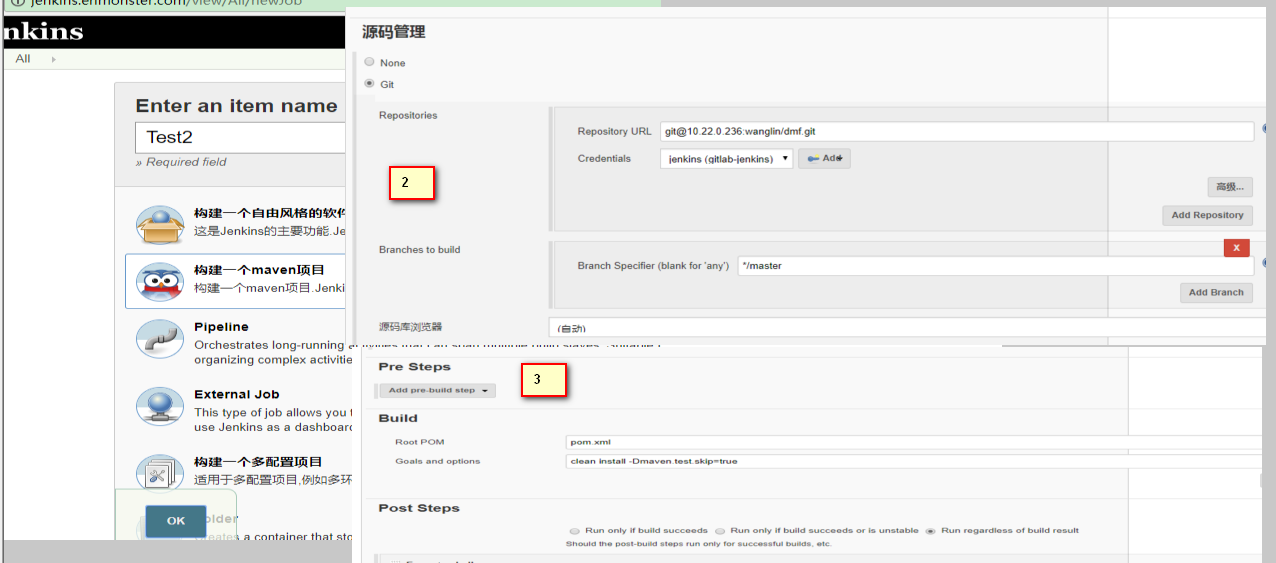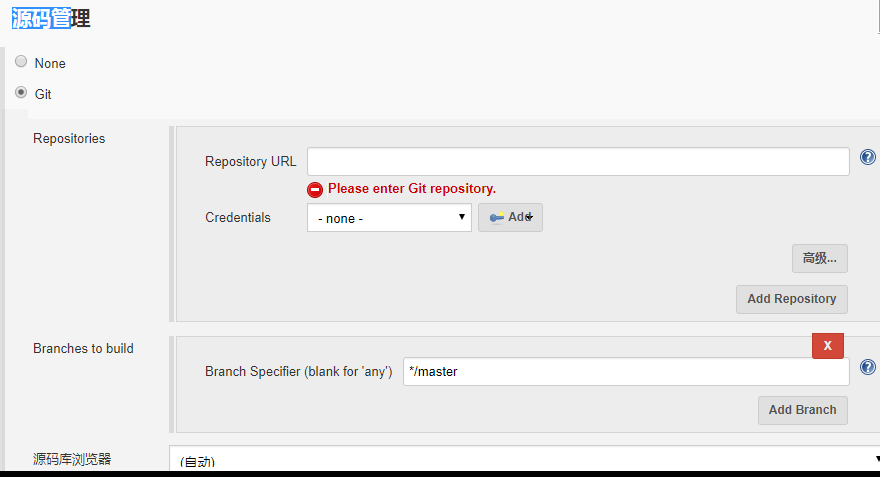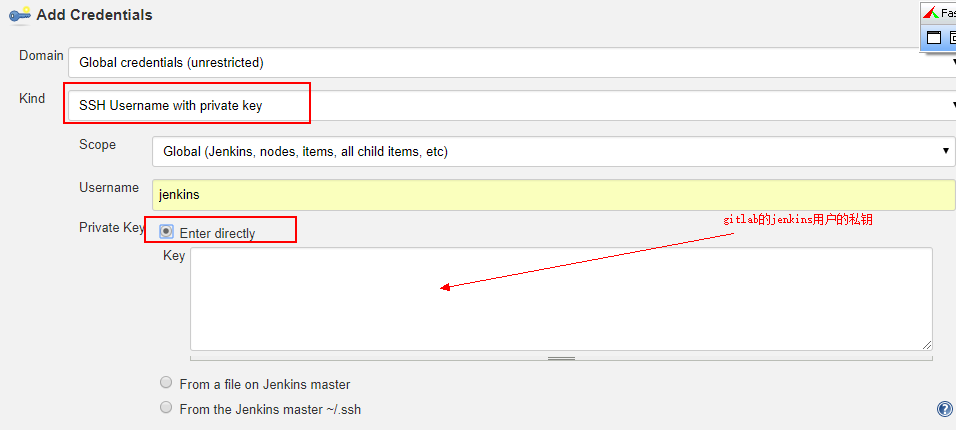gitlab+jenkins持续集成(二)
1.jenkins服务器上的配置
tar -zxvf apache-maven-3.3.-bin.tar.gz -C /opt/
yum install -y git
cat /opt/apache-maven-3.3./conf/settings.xml #只需更改maven的地址
<?xml version="1.0" encoding="UTF-8"?> <!--
Licensed to the Apache Software Foundation (ASF) under one
or more contributor license agreements. See the NOTICE file
distributed with this work for additional information
regarding copyright ownership. The ASF licenses this file
to you under the Apache License, Version 2.0 (the
"License"); you may not use this file except in compliance
with the License. You may obtain a copy of the License at http://www.apache.org/licenses/LICENSE-2.0 Unless required by applicable law or agreed to in writing,
software distributed under the License is distributed on an
"AS IS" BASIS, WITHOUT WARRANTIES OR CONDITIONS OF ANY
KIND, either express or implied. See the License for the
specific language governing permissions and limitations
under the License.
--> <!--
| This is the configuration file for Maven. It can be specified at two levels:
|
| 1. User Level. This settings.xml file provides configuration for a single user,
| and is normally provided in ${user.home}/.m2/settings.xml.
|
| NOTE: This location can be overridden with the CLI option:
|
| -s /path/to/user/settings.xml
|
| 2. Global Level. This settings.xml file provides configuration for all Maven
| users on a machine (assuming they're all using the same Maven
| installation). It's normally provided in
| ${maven.home}/conf/settings.xml.
|
| NOTE: This location can be overridden with the CLI option:
|
| -gs /path/to/global/settings.xml
|
| The sections in this sample file are intended to give you a running start at
| getting the most out of your Maven installation. Where appropriate, the default
| values (values used when the setting is not specified) are provided.
|
|-->
<settings xmlns="http://maven.apache.org/SETTINGS/1.0.0"
xmlns:xsi="http://www.w3.org/2001/XMLSchema-instance"
xsi:schemaLocation="http://maven.apache.org/SETTINGS/1.0.0 http://maven.apache.org/xsd/settings-1.0.0.xsd">
<!-- localRepository
| The path to the local repository maven will use to store artifacts.
|
| Default: ${user.home}/.m2/repository
<localRepository>/path/to/local/repo</localRepository>
-->
<localRepository>/opt/apache-maven-3.3.9/repo</localRepository> <!-- interactiveMode
| This will determine whether maven prompts you when it needs input. If set to false,
| maven will use a sensible default value, perhaps based on some other setting, for
| the parameter in question.
|
| Default: true
<interactiveMode>true</interactiveMode>
--> <!-- offline
| Determines whether maven should attempt to connect to the network when executing a build.
| This will have an effect on artifact downloads, artifact deployment, and others.
|
| Default: false
<offline>false</offline>
--> <!-- pluginGroups
| This is a list of additional group identifiers that will be searched when resolving plugins by their prefix, i.e.
| when invoking a command line like "mvn prefix:goal". Maven will automatically add the group identifiers
| "org.apache.maven.plugins" and "org.codehaus.mojo" if these are not already contained in the list.
|-->
<pluginGroups>
<!-- pluginGroup
| Specifies a further group identifier to use for plugin lookup.
<pluginGroup>com.your.plugins</pluginGroup>
-->
</pluginGroups> <!-- proxies
| This is a list of proxies which can be used on this machine to connect to the network.
| Unless otherwise specified (by system property or command-line switch), the first proxy
| specification in this list marked as active will be used.
|-->
<proxies>
<!-- proxy
| Specification for one proxy, to be used in connecting to the network.
|
<proxy>
<id>optional</id>
<active>true</active>
<protocol>http</protocol>
<username>proxyuser</username>
<password>proxypass</password>
<host>proxy.host.net</host>
<port>80</port>
<nonProxyHosts>local.net|some.host.com</nonProxyHosts>
</proxy>
-->
</proxies> <!-- servers
| This is a list of authentication profiles, keyed by the server-id used within the system.
| Authentication profiles can be used whenever maven must make a connection to a remote server.
|-->
<servers>
<!-- server
| Specifies the authentication information to use when connecting to a particular server, identified by
| a unique name within the system (referred to by the 'id' attribute below).
|
| NOTE: You should either specify username/password OR privateKey/passphrase, since these pairings are
| used together.
|
<server>
<id>deploymentRepo</id>
<username>repouser</username>
<password>repopwd</password>
</server>
--> <!-- Another sample, using keys to authenticate.
<server>
<id>siteServer</id>
<privateKey>/path/to/private/key</privateKey>
<passphrase>optional; leave empty if not used.</passphrase>
</server>
-->
</servers> <!-- mirrors
| This is a list of mirrors to be used in downloading artifacts from remote repositories.
|
| It works like this: a POM may declare a repository to use in resolving certain artifacts.
| However, this repository may have problems with heavy traffic at times, so people have mirrored
| it to several places.
|
| That repository definition will have a unique id, so we can create a mirror reference for that
| repository, to be used as an alternate download site. The mirror site will be the preferred
| server for that repository.
|-->
<mirrors>
<!-- mirror
| Specifies a repository mirror site to use instead of a given repository. The repository that
| this mirror serves has an ID that matches the mirrorOf element of this mirror. IDs are used
| for inheritance and direct lookup purposes, and must be unique across the set of mirrors.
|
<mirror>
<id>mirrorId</id>
<mirrorOf>repositoryId</mirrorOf>
<name>Human Readable Name for this Mirror.</name>
<url>http://my.repository.com/repo/path</url>
</mirror>
-->
<!---mirror>
<!id>nexus</id>
<mirrorOf>nexussi</mirrorOf>
<name>nexusname</name>
<url>http://maven.enmonster.com/nexus/content/repositories/central/</url>
</mirror-->
<mirror>
<id>nexus</id>
<mirrorOf>central</mirrorOf>
<name>nexus private repository</name>
<url>http://maven.XXX.com/nexus/content/groups/public/</url>
</mirror>
</mirrors> <!-- profiles
| This is a list of profiles which can be activated in a variety of ways, and which can modify
| the build process. Profiles provided in the settings.xml are intended to provide local machine-
| specific paths and repository locations which allow the build to work in the local environment.
|
| For example, if you have an integration testing plugin - like cactus - that needs to know where
| your Tomcat instance is installed, you can provide a variable here such that the variable is
| dereferenced during the build process to configure the cactus plugin.
|
| As noted above, profiles can be activated in a variety of ways. One way - the activeProfiles
| section of this document (settings.xml) - will be discussed later. Another way essentially
| relies on the detection of a system property, either matching a particular value for the property,
| or merely testing its existence. Profiles can also be activated by JDK version prefix, where a
| value of '1.4' might activate a profile when the build is executed on a JDK version of '1.4.2_07'.
| Finally, the list of active profiles can be specified directly from the command line.
|
| NOTE: For profiles defined in the settings.xml, you are restricted to specifying only artifact
| repositories, plugin repositories, and free-form properties to be used as configuration
| variables for plugins in the POM.
|
|-->
<profiles>
<!-- profile
| Specifies a set of introductions to the build process, to be activated using one or more of the
| mechanisms described above. For inheritance purposes, and to activate profiles via <activatedProfiles/>
| or the command line, profiles have to have an ID that is unique.
|
| An encouraged best practice for profile identification is to use a consistent naming convention
| for profiles, such as 'env-dev', 'env-test', 'env-production', 'user-jdcasey', 'user-brett', etc.
| This will make it more intuitive to understand what the set of introduced profiles is attempting
| to accomplish, particularly when you only have a list of profile id's for debug.
|
| This profile example uses the JDK version to trigger activation, and provides a JDK-specific repo.
<profile>
<id>jdk-1.4</id> <activation>
<jdk>1.4</jdk>
</activation> <repositories>
<repository>
<id>jdk14</id>
<name>Repository for JDK 1.4 builds</name>
<url>http://www.myhost.com/maven/jdk14</url>
<layout>default</layout>
<snapshotPolicy>always</snapshotPolicy>
</repository>
</repositories>
</profile>
--> <!--
| Here is another profile, activated by the system property 'target-env' with a value of 'dev',
| which provides a specific path to the Tomcat instance. To use this, your plugin configuration
| might hypothetically look like:
|
| ...
| <plugin>
| <groupId>org.myco.myplugins</groupId>
| <artifactId>myplugin</artifactId>
|
| <configuration>
| <tomcatLocation>${tomcatPath}</tomcatLocation>
| </configuration>
| </plugin>
| ...
|
| NOTE: If you just wanted to inject this configuration whenever someone set 'target-env' to
| anything, you could just leave off the <value/> inside the activation-property.
|
<prof/opt/apache-maven-3.3.9/repo <id>env-dev</id> <activation>
<property>
<name>target-env</name>
<value>dev</value>
</property>
</activation> <properties>
<tomcatPath>/path/to/tomcat/instance</tomcatPath>
</properties>
</profile>
-->
</profiles> <!-- activeProfiles
| List of profiles that are active for all builds.
|
<activeProfiles>
<activeProfile>alwaysActiveProfile</activeProfile>
<activeProfile>anotherAlwaysActiveProfile</activeProfile>
</activeProfiles>
-->
</settings>
[root@jenkins apache-maven-3.3.]# tail /etc/profile unset i
unset -f pathmunge
MVN_HOME=/opt/apache-maven-3.3.
PATH=$PATH:$MVN_HOME/bin
export MVN_HOME
export PATH
2.jenkins页面上的配置
①maven配置 "Global Tool Configuration"



3.jenkins服务器上的配置

4. jenkins打通gitlab



gitlab+jenkins持续集成(二)的更多相关文章
- 持续集成之Jenkins+Gitlab实现持续集成 [二]
持续集成之Jenkins+Gitlab实现持续集成 [二] 项目:使用git+jenkins实现持续集成 开始构建 General 源码管理 我们安装的是Git插件,还可以安装svn插件 我们将 ...
- CentOS 7 Gitlab+Jenkins持续集成+自动化部署
基于上次的环境<部署Gitlab+Jenkins持续集成环境> 来实现自动化部署 系统管理–>插件管理–>安装以下插件: Credentials Plugin(默认已经安装) ...
- Jekens 配置多项目SCM GitLab+Jenkins持续集成环境
参考: 搭建GitLab+Jenkins持续集成环境图文教程 https://blog.csdn.net/ruangong1203/article/details/73065410 Jenkins中配 ...
- CentOS 7 部署Gitlab+Jenkins持续集成(CI)环境
持续集成概述及运行流程 : 持续集成概述 :持续集成(Continuous integration)持续集成是指开发者在代码的开发过程中 ,可以频繁的将代码部署集成到主干,并进行自动化测试 开发→代 ...
- GitLab+Jenkins持续集成
一.概述 GitLab是一个代码仓库,用来管理代码.Jenkins是一个自动化服务器,可以运行各种自动化构建.测试或部署任务.所以这两者结合起来,就可以实现开发者提交代码到GitLab,Jenkins ...
- 【Jenkins持续集成(二)】Windows上安装Jenkins教程
一.前言 Jenkins是一款开源 CI&CD 软件,用于自动化各种任务,包括构建.测试和部署软件. Jenkins 支持各种运行方式,可通过系统包.Docker 或者通过一个独立的 Java ...
- gitlab+jenkins持续集成(一)
1. 环境:CentOS7.0,jdk-8u91-linux-x64.rpm,jenkins 2.7.4 ,gitlab 9.2.2 2. 安装jdk,jenkins (rpm -ivh ...
- gitlab+jenkins持续集成(三)
构建: 需要将jenkins服务器上 jenkins用户的公钥发送给 目标服务器的gs用户,使得在jenkins上能用gs免密登录目标服务器 复制密钥到目标机器上(需要登录到的机器) ssh-co ...
- git+jenkins持续集成二-jenkins定时构建语法:定时构建语法
构建位置:选择或创建工程_设置_构建触发器 1. 定时构建语法:* * * * * (五颗星,多个时间点,中间用逗号隔开)第一个*表示分钟,取值0~59第二个*表示小时,取值0~23第三个*表示一个月 ...
随机推荐
- python第八课——random模块的使用
2.2.如何获取随机整数值? 引入random模块的使用 randint(a,b)函数:作用:返回给程序一个[a,b]范围内的随机整数注意:含头含尾闭区间 思路步骤: 第一步:导入random模块到相 ...
- 4-3 R语言函数 mapply
#mapply(函数/函数名,数据,函数相关的函数) > list(rep(1,4),rep(2,3),rep(3,2),rep(4,1)) [[1]] [1] 1 1 1 1 [[2]] [1 ...
- git使用,在ubuntu中
#安装sudo apt install git要先到github官网建一个账号. #配置 你的github git config --global user.name "fanbrightu ...
- 3631. [JLOI2014]松鼠的新家【树形DP】
Description 松鼠的新家是一棵树,前几天刚刚装修了新家,新家有n个房间,并且有n-1根树枝连接,每个房间都可以相互到达,且俩个房间之间的路线都是唯一的.天哪,他居然真的住在“树”上.松鼠想邀 ...
- [USACO09OPEN]Ski Lessons
嘟嘟嘟 先考虑这两点: 1.如果我们有结束时间相同的课程,且达到的能力相同,那么我们一定选择开始时间最晚的. 2.如果有能力值相同的滑雪坡,我们一定选择时间最短的. 因此先预处理两个数组.cla[i] ...
- 【转】Android 旋转动画,停止和持续旋转
旋转180度后停止 RotateAnimation rotate; rotate =new RotateAnimation(0f,180f,Animation.RELATIVE_TO_SELF, 0. ...
- PHP运行模式简单总结
众所周知,PHP有多种运行模式,那么这些模式各自有什么特点,它们之间又有什么区别呢,本文将作一个简单的总结: CGI 模式 所谓 CGI (Common Gateway Interface) 是指通用 ...
- ArrayList实现原理及源码分析之JDK8
转载 ArrayList源码分析 一.ArrayList介绍 Java 集合框架主要包括两种类型的容器: 一种是集合(Collection),存储一个元素集合. 一种是图(Map),存储键/值对映射. ...
- Red Hat Linux 挂载外部资源
在我们安装的Red Hat Linux 中.当中一半机器为最主要的server配置,没有桌面环境.在从U盘上复制文件的时候可就犯难了.在网上查了查才知道.要訪问U盘就必须先将它们挂载到Linux系统的 ...
- Eclipse设置格式化每行字符的长度
Windows>>prefrence>>Java>>CodeStyle>>formatter>>edit>>line wrapp ...
